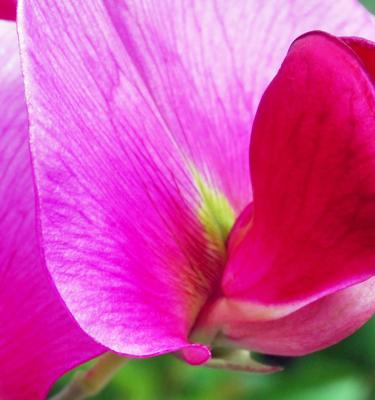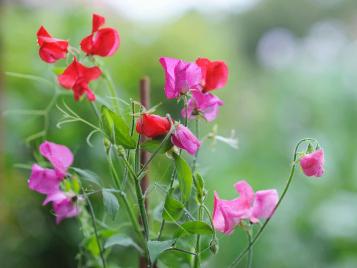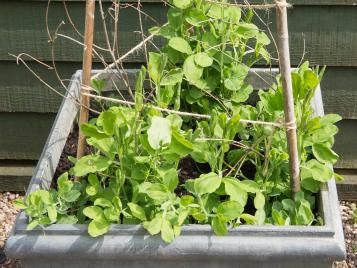

How to grow and care for sweet peas
Sweet peas (Lathyrus odoratus) are an incredibly popular summer climbing plant. They produce masses of flowers all summer long - providing they are picked regularly – and most (but not all) varieties have a delicious scent. Sweet peas are easy to grow from seed, or you can also buy young plants from garden centres in spring.
Suggested planting locations and garden types
You can plant sweet peas in flower borders and beds, patios, containers, cut flowers, city and courtyard gardens, cottage and informal gardens, walls and fences. Sweet peas need a sunny position and good, well-drained soil. Before sowing sweet pea seeds or planting out, improve the soil with bulky organic matter or soil conditioner to help hold plenty of moisture.

What you’ll need to start growing sweet peas
This list of equipment will get your sweet pea growing off to a great start. Here’s what you’ll need:
- Garden fork and spade
- Trowel
- Well-rotted farmyard manure
- General purpose fertilizer
- High-potash feed
- 9cm (3.5in) pots
- Seed sowing compost
- Pea sticks, bamboo canes or other support framework
- String or twine
- Sweet pea seeds
Sowing sweet peas
For best results, sow seeds in long pots filled with a good seed sowing compost in March or April. Sow seeds individually in 9cm (3.5") pots or 5-7 seeds in a 12.5cm (5") pot. Germinate and grow on the plants at about 15°C (60°F). If several seeds are sown into a pot, pot on seedlings individually into 9cm (3.5in) pots when they reach about 5cm (2") high.
You can sow seeds directly into the ground in March or April or even May, but the results are usually not as good. In milder areas, you can also sow in pots during October or November and overwinter the young plants in a cold frame or unheated greenhouse. This will produce plants that flower earlier the following year.
Some varieties have a hard seed coat and may be difficult to germinate. The advice to chip away part of the hard seed coat using a sharp knife to help germination isn’t always necessary. If you want to try, make a small nick on the opposite side to the ‘eye’. Certainly don’t soak the seeds in water as this can lead to rotting.
How to care for sweet peas
When plants are about 7.5-10cm (3-4") high, pinch out the growing tips to encourage branching, bushier plants and so more flowers.
Plant out overwintered plants in mid-spring and those sown in spring in late spring or early summer, after first hardening them off. The plants may need protection from cold and late frosts, so it may be better to wait until after the final spring frost. Plant 20-30cm (8-12") apart.
After planting out, water the plants thoroughly to settle them in and again during dry spells.
Feeding regularly throughout summer with a high potash liquid feed will help promote continuous flowering.
Cut flowers frequently as they become ready, and certainly before the flowers fade and they produce seed pods. Otherwise they will stop flowering.
Drying out, drought and temperature-related stress causes flower bud drop.
Training and supports for sweet peas
Sweet peas are usually grown up pea sticks, wigwams of bamboo canes, trellis or post and netting supports. They can either be left to their own devices and allowed to scramble for a natural look or carefully trained and tied in.
Dwarf, bushy varieties of sweet peas are perfect for pots, hanging baskets or even as ground cover.

Sweet pea cordon training
Cordon training is used by professional growers and gardeners who regularly exhibit plants as it produces the best, top quality blooms. But it is labour intensive.
In the cordon system, sweet peas are trained as single-stemmed plants, tied to individual bamboo canes. All the sideshoots and tendrils are carefully removed when they form, so that all the plant’s energy is put into producing flowers, and the plants have to be tied in regularly to the canes.
Common pests and diseases in sweet peas
Powdery mildew on sweet peas
Powdery mildew is a fungal disease that appears as a white powder on sweet pea leaves, stunting growth and causing leaves to shrivel. Drought-stressed plants are more susceptible to this disease.
- Dig organic material into the soil before planting to improve soil water retention.
- Space sweet peas when planting to ensure good air circulation.
- Remove any affected growth promptly.
- Water regularly in dry periods.
Slugs and snails on sweet peas
Slugs and snails will attack young sweet pea seedlings, eating the leaves. They can be identified by the slime trails that they leave, as well as the damage they do.
- Check plants at night and remove slugs and snails by hand.
- Covering the soil around plants with crushed eggshells or grit may have some effect.
- Scatter environmentally-friendly slug pellets if other methods are insufficient.
Aphids on sweet peas
Aphids can be a problem on sweet peas. They are sap-sucking insects which can quickly infest new shoots on young sweet pea plants, stunting growth.
- Wipe off small colonies with a damp cloth.
- Encourage natural predators like ladybirds and hoverflies.
- Pesticide sprays are available for aphids.



